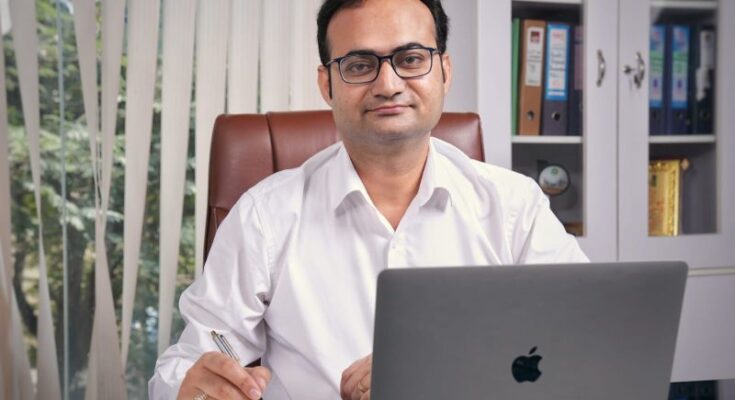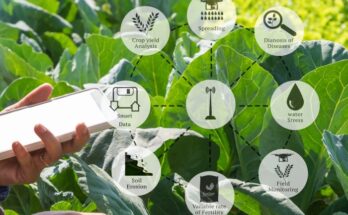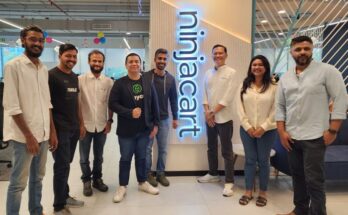High-resolution satellite data, combined with AI algorithms, enable precise monitoring and analysis of agricultural landscapes. All these facilitated the adoption of AI-powered agricultural solutions that empower farmers with actionable insights, real-time information, and decision-support tools to enhance productivity, sustainability, and resilience in farming practices. Sat Kumar Tomer, Founder and CEO of Satyukt Analytics speaks to Mohd Mustaquim future of digitisation of agriculture…
Excerpts:
Kindly brief us about the technological solutions Satyukt Analytics offers to the farming sector.
We have a satellite-based technology called Sat2Farm, which is a simple mobile application. It provides precision agriculture information to assist the farming community in gaining a better understanding of the health of farms, provides irrigation advisories, pest and disease forewarnings and helps them with crop insights, removing all guesswork and trial and error from farm operations and allowing you to gain more control over the factors that affect farm yield.
You may also like to read – More intelligent AI algorithms for the agriculture sector coming soon: Mohit Pande, CBO, CropIn
Over the past 10 years, how have AI algorithms and modern technologies evolved and transformed themselves making solutions smarter for the agriculture sector?
Internet penetration in India has increased fourfold in the past decade, taking India to 2nd position in the world in terms of active internet users. The proliferation of mobile devices, particularly smartphones, has significantly contributed to increased internet availability. India is one of the largest smartphone markets in the world, although the penetration rate is still relatively low. Affordable feature phones and entry-level smartphones have become increasingly accessible to rural consumers, driving mobile adoption in these regions. Besides, Government initiatives such as Digital India have aimed to promote mobile penetration and internet access across the country. High-resolution satellite data, combined with AI algorithms, enable precise monitoring and analysis of agricultural landscapes. All these facilitated the adoption of AI-powered agricultural solutions that empower farmers with actionable insights, real-time information, and decision-support tools to enhance productivity, sustainability and resilience in farming practices.
Data is considered a new goldmine in today’s world. You are a data analytics company, how is it going to bring precision to agricultural practices in the coming years?
The integration of satellite data and machine learning supports precision farming by providing farmers with timely, accurate, and actionable insights. Satellites supply raw data, which, when combined with machine learning, is transformed into valuable insights that benefit farmers. By leveraging these technologies, farmers can optimise resource use, minimise risks, improve yields, and promote environmental sustainability, leading to a more resilient and productive agricultural sector.
You may also like to read – AgriClimate Tech – Iyris partners with Magrabi Agriculture to expand hot climate agriculture technologies
PMFBY has integrated satellite imagery for risk assessment. How has it changed the crop insurance practices from the traditional ones? Satyukt Analytics is also providing such solutions. Kindly elaborate on them briefly…
The integration of satellite technology in risk assessment has indeed revolutionised crop insurance practices, offering several advantages over traditional methods like real-time monitoring, improved accuracy, scalability, timely response to claims, reduced administrative burdens and better support to farmers in managing agricultural risks.
Satellite tech is our comprehensive solution for risk assessment in the face of nature’s challenges. Satyukt Analytics is able to estimate the flood-impacted farms and the extent and severity of flooding in agricultural areas. We also estimate farms impacted by prevented sowing using satellite technology. That is to assess the areas where farmers were unable to plant crops due to various factors such as adverse weather conditions, waterlogging, or other constraints. This enables stakeholders to gain timely and accurate information about the extent of agricultural disruptions, enabling targeted interventions and support measures to mitigate the impacts on farmers. Our satellite data is used for early warning systems, risk monitoring, and loss assessment, allowing insurers to identify areas at high risk of crop failure and allocate resources more effectively.
You may also like to read – WRMS showcases innovations for a sustainable future at Bihar Climate Action Expo 2024
How is data analytics bringing in a paradigm shift in agronomy services such as soil and crop health management, crop nutrition, soil moisture and irrigation practices?
Data analytics contributes by improving the yield of farms at less cost through the efficient use of natural resources; monitoring the health of crops routinely without extra labour and hassles; conserving water by using the exact amount required to irrigate crops and avoiding the excessive use of water; getting insights on crop health without physical field visits; precise application of soil nutrients depending on the soil requirement avoiding the nutrient toxicity and many other ways.
Insufficient digital literacy is considered a big roadblock among farmers, so how does it create a challenge for you to deliver farmer-oriented agronomy solutions and how do you tackle it?
Literacy rate in India has been increasing, the remarkable 26 per cent increase in literacy rates among rural women in India over the past decade represents a significant leap forward. It is helping to improve farmers’ ability to understand and adopt modern agricultural practices.
However, insufficient digital literacy is still a big roadblock to delivering farmer-oriented solutions. To address this challenge, Satyukt Analytics has designed an application with a user-friendly interface, to help farmers become comfortable with using Sat2Farm. Language and cultural differences can pose barriers to adoption, especially among non-native-speaking communities. We address this by offering multilingual support ensuring that our agronomy solutions are accessible and inclusive to all farmers. We aim to overcome barriers to digital literacy and empower farmers to harness the full potential of agronomy solutions like Sat2Farm for sustainable agriculture.
You may also like to read – Marut Drones and PJTSAU’s direct seeding drone receives ‘world’s first’ utility patent
How do you envisage the next 10 years of modern digital technological solutions going to transform agricultural practices?
The widespread adoption of smartphones in rural India by 2040 will catalyse the digitisation of agriculture and rural development, unlocking opportunities for economic growth, empowerment, and sustainable livelihoods in rural communities. However, efforts will be needed to ensure equitable access to smartphones, digital literacy, and infrastructure development to maximise the benefits of this digital transformation.
What new offerings are you going to provide in the near future?
By seamlessly incorporating our new technology into existing monitoring frameworks, BFSI (Banking, Financial Services, and Insurance) entities can gain unparalleled access to a wealth of precise, scalable, and up-to-the-minute information regarding various aspects of risk assessment and to assess creditworthiness. This enables BFSI professionals to make informed decisions swiftly and effectively.
Satyukt Analytics is able to monitor large agricultural areas without the need for physical field visits and provide macro insights. This temporal monitoring allows for the observation of the progression of crop growth which helps farmers schedule farm activities like never before at the most appropriate times, ensuring optimal product quality and yield, optimal supply chain planning by agriculture companies and facilitating better decision-making by policy makers.
You may also like to read – AI drones and biological fertilisers shaping the future of farming
Corporations can efficiently meet their emission reduction targets with our advanced soil monitoring satellite-based technology. Simultaneously, farmers can leverage this technology to enhance their soil fertility, fostering sustainable agricultural practices.
How is fintech making inroads among the farming community? What are the challenges and what are the way-outs?
Fintech, or financial technology, is increasingly making inroads in the farming community, offering innovative solutions to address various financial needs and challenges faced by farmers. In the case of crop insurance and risk management, lack of credit history and financial literacy among farmers, traditional methods of assessing creditworthiness are the few challenges which can be highlighted.
Farmers gain access to real-time, accurate, and scalable information by integrating satellite technology into farm risk assessment. This approach not only streamlines the risk management process but also speeds up the loan approval process by the banking institutions.
Over 80 per of Indian farmers are small and marginal, how is it challenging to convince the small-scale landholders to offer such tech-oriented solutions and how do they benefit from your services?
Small and marginal farmers often face challenges in accessing and adopting modern agricultural technologies due to factors such as limited resources and infrastructure. Our technology offers an affordable solution accessible to small and marginal farmers who may have limited resources. Indeed, it offers a relatively simple yet powerful solution for farmers due to its user-friendly interface and accessibility.
You may also like to read – Government programmes for adoption of digital and innovative farming technologies
Our solutions enable site-specific crop management ensuring profitability and sustainability enabling small and marginal farmers to manage their crops efficiently. They minimise agri-input costs; maximise crop yield by up to 30 to 40 per cent; serve satellite data within minutes; reduce water consumption by up to 10-12 per cent; encourage sustainable farming practices; remote monitoring of farms saves 70 per cent of the time and identify poorly performing areas.
Amid threats of climate change, declining natural resources and growing population, sustainability is a big issue in agriculture today. How do Satyukt Analytics’ tech-enabled solutions engage farmers to adopt sustainable farming practices?
Satyukt Analytics’ satellite remote sensing technology plays a crucial role in promoting sustainability by enabling more efficient resource use, reducing environmental impact, and enhancing resilience to climate. We provide solutions for optimised resource management. It may be water, fertilisers, pesticides or any other agricultural inputs to use in optimal quantities. By implementing precision application techniques, farmers can apply fertilisers and pesticides only where needed. This reduces the overall use of chemicals in agriculture, minimising pollution and preserving soil and water quality.
By optimising inputs and addressing crop health issues promptly, our solution helps farmers maximise crop yields and improve product quality. This not only increases farm profitability but also contributes to food security sustainability.





